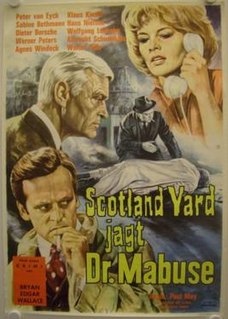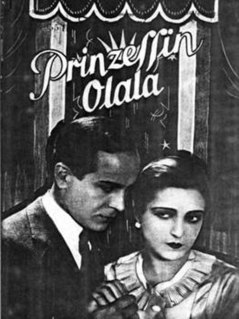
Gainsborough Pictures was a British film studio based on the south bank of the Regent's Canal, in Poole Street, Hoxton in the former Metropolitan Borough of Shoreditch, north London. Gainsborough Studios was active between 1924 and 1951. The company was initially based at Islington Studios, which were built as a power station for the Great Northern & City Railway and later converted to studios.

German Expressionism consisted of several related creative movements in Germany before the First World War that reached a peak in Berlin during the 1920s. These developments were part of a larger Expressionist movement in north and central European culture in fields such as architecture, dance, painting, sculpture and cinema. This article deals primarily with developments in German Expressionist cinema before and immediately after World War I, approximately from 1910 to the 1930s.

Jane Novak was an American actress of the silent film era.

Scotland Yard Hunts Dr. Mabuse or Scotland Yard vs. Dr Mabuse is a 1963 German crime film directed by Paul May and starring Peter van Eyck. Scotland Yard vs. Dr. Mabuse was distributed in West Germany by Gloria Film, premiering on 20 September 1963. The film was written by Ladislas Fodor, based on a story idea written by Bryan Edgar Wallace. It was shot at the Spandau Studios in Berlin. The film's sets were designed by the art directors Albrecht Hennings and Hans Kuhnert

Walter Rilla was a German film actor of Jewish descent. He appeared in more than 130 films between 1922 and 1977. He was born in Neunkirchen, Germany and died in Rosenheim, Germany.
Happy Ever After is a 1932 British-German musical film directed by Paul Martin and Robert Stevenson, and starring Lilian Harvey, Jack Hulbert, Cicely Courtneidge, Sonnie Hale, and Edward Chapman.

The Queen Was in the Parlour is a 1927 Anglo-German silent drama film directed by Graham Cutts and starring Lili Damita, Louis Ralph and Paul Richter. It was based on the Noël Coward play The Queen Was in the Parlour. Its German title was Die letzte Nacht.

The Gallant Hussar is a 1928 German-British romance film directed by Géza von Bolváry and starring Ivor Novello, Evelyn Holt, and Paul Hörbiger. It was based on a story by the Hungarian writer Arthur Bárdos and Margarete-Maria Langen.
The Blackguard is 1923 novel by Raymond Paton. It is a melodrama set during the Russian Revolution of 1917. A French violinist rescues a Russian princess from execution at the hands of revolutionaries led by his former mentor.

The Prude's Fall is a 1925 British silent drama film directed by Graham Cutts and starring Jane Novak, Julanne Johnston and Warwick Ward.

Bavaria Studios are film production studios located in Munich, the capital of the region of Bavaria in Germany, and a subsidiary of Bavaria Film.
Villa Falconieri is a 1928 German-Italian silent drama film directed by Richard Oswald and starring Maria Jacobini, Hans Stüwe, and Eve Gray. It was based on the 1896 novel of the same title by Richard Voss.

The Private Life of Louis XIV or Liselotte of the Palatinate is a 1935 German historical film directed by Carl Froelich and starring Renate Müller, Eugen Klöpfer and Maria Krahn. It was shot at the Tempelhof Studios in Berlin and premiered at the city's UFA-Palast am Zoo. The sets were designed by the art directors Walter Haag and Franz Schroedter. The film's English language release title is a reference to the hit British film The Private Life of Henry VIII (1933).

The Forger of London is a 1961 West German crime film directed by Harald Reinl and starring Karin Dor, Hellmut Lange and Siegfried Lowitz. It is an adaptation of Edgar Wallace's 1927 novel The Forger, and part of a long-running series of German Wallace films made during the decade.

24 Hours in the Life of a Woman is a 1931 German drama film directed by Robert Land and starring Henny Porten, Walter Rilla and Friedrich Kayßler. It is based on Stefan Zwieg's novella Twenty-Four Hours in the Life of a Woman. The film was produced by Seymour Nebenzal's Nero Film in conjunction with Porten's own production company. It was shot at the Terra Studios in Berlin. The film's art direction was by Franz Schroedter.
Fire of Love is a 1925 German silent film directed by Paul L. Stein and starring Liane Haid, Alfons Fryland, and Walter Rilla.

Princess Olala is a 1928 German silent drama film directed by Robert Land and starring Carmen Boni, Walter Rilla, Marlene Dietrich and Hans Albers. It is also known by the alternative title of Art of Love.
The Men Around Lucy is a 1931 American drama film directed and produced by Alexander Korda and starring Liane Haid, Walter Rilla and Oskar Karlweis. Made at the Joinville Studios in Paris, it is one of several multi-language versions of the 1930 film Laughter, with distribution in Germany by UFA as part of the Parufamet agreement. The movie is considered lost.
The Only Girl is a 1933 British-German musical film directed by Friedrich Hollaender and starring Lilian Harvey, Charles Boyer, and Mady Christians. It is the English-language version of The Empress and I which also starred Harvey and Christians. It was the last in a series of MLV co-productions between UFA and Gainsborough Pictures. It was released in the United States in 1934 by Fox Film.













